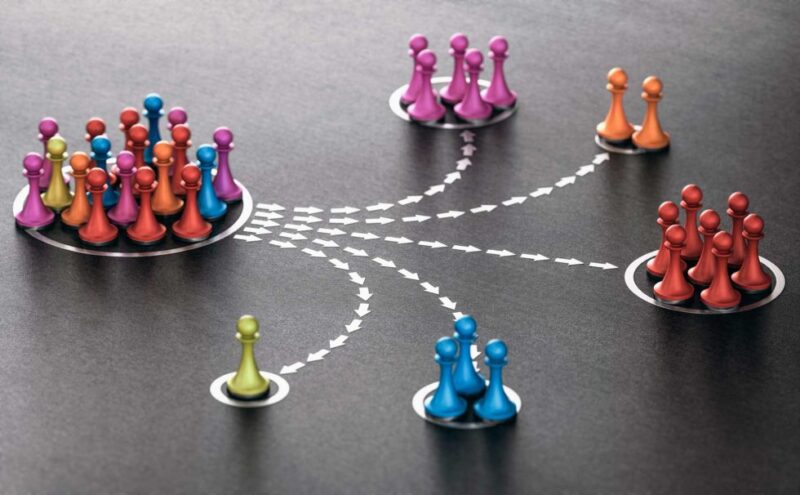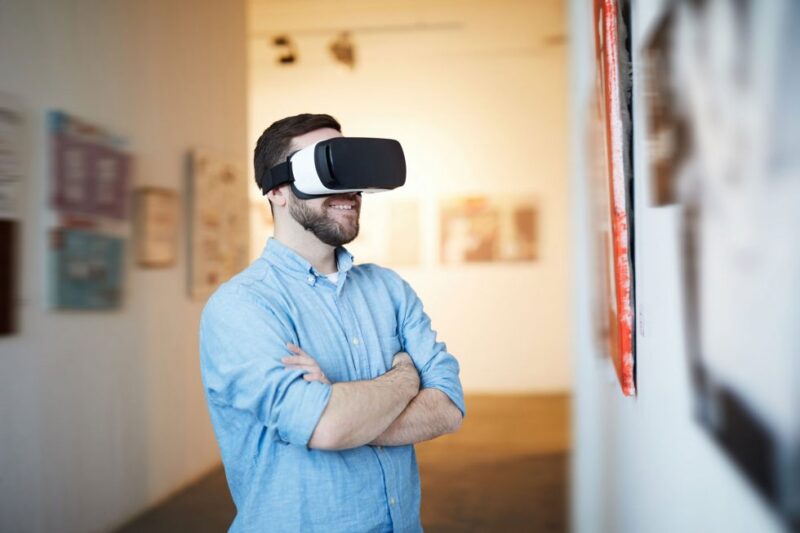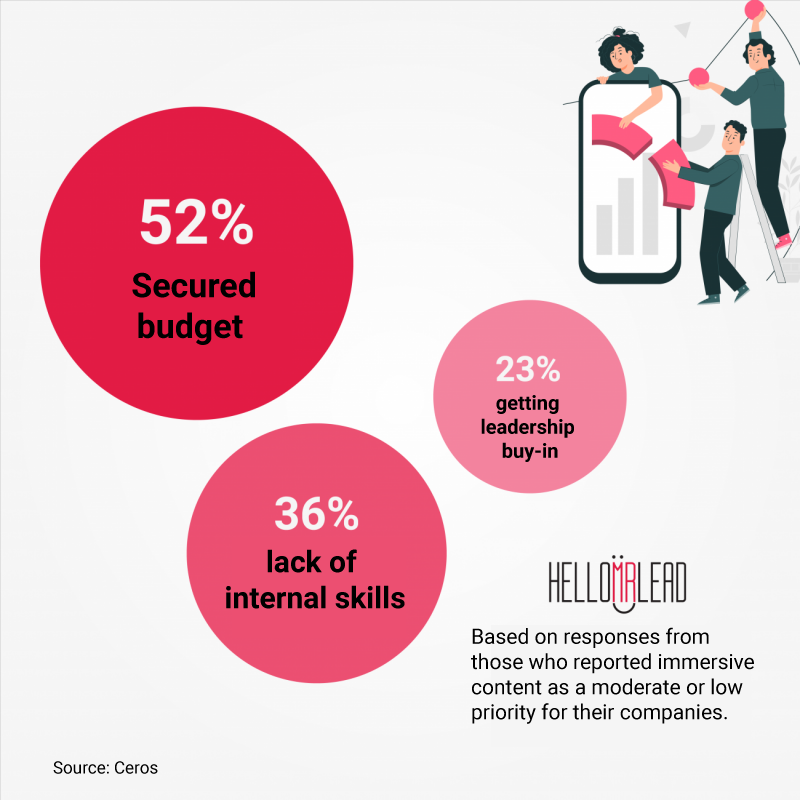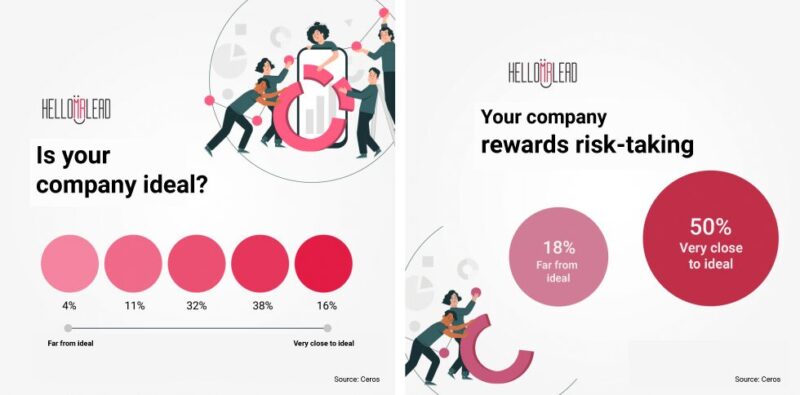In this article we will show you what is immersive marketing, what is this technique, how to apply it to your company, its advantages and some examples to keep you up to date on this subject that has shaken the technological revolution.
INDEX
- What is immersive marketing?
- Applications of immersive marketing.
- Features.
- How to apply immersive marketing to your business?
- Advantages of immersive marketing.
- Examples.
- Immersive vs static content.
- Idealization of the company.
1. What is immersive marketing?
Shopping, visiting a museum or traveling to another country is now possible from the sofa of your home, all these experiences are possible thanks to immersive marketing, but it is not only about teleporting to the place where the events occur.
Thanks to immersive marketing companies can create a product with a history that is also part of the user who plans to buy it, that is, the customer can be part of the concept from home.
Today the user cannot be a mere spectator, if he feels out of place will resort to competition, so it is very important to make him participate in all the actions we are carrying out. The story should be the center of the marketing strategy, and with it the user, so the buyer can interact with it.
In this way a link is generated between company – customer, and you will feel part of the company. This type of strategy is based on the use of videos, events or experiences in their content, in fact, some of these elements can be multi-sensory which increases the feeling of participation.

To carry out this type of experience is necessary technology, that tool that today seems to be important in all sectors of companies. Yes, it may seem difficult to get used to certain tools, but once they are launched they will make a difference.
With the stratospheric leap we have taken at the level of digitalization, companies already have the necessary systems to launch this type of experience. With confinement we have gotten used to attending events online, concerts or even buying everything through eCommerces.
Companies have adapted to this and have become active in developing increasingly innovative and surprising marketing strategies for their users.
The creation of such strategies is a challenge and there are already many corporations that join to try this type of marketing, thanks to such practices users will not go unnoticed in front of our campaigns. Thus, we will avoid the immune effect of advertising, the user will go from being a passive advertising customer to an asset in the company’s stories.
2. Applications of immersive marketing.
There are different ways to implement immersive marketing in your company, according to a study by Kaizen Institute, this type of content has experienced great growth since 2019, thanks to increased user participation and new experience. Here are some of its applications:
- Virtual reality
This type of tool can be difficult to reach for some customers since it is necessary to have virtual reality glasses, but it can be applicable to a tourism company in which you want to show a tour using these glasses.
- Augmented reality
Surely this tool sounds to you since you have seen models in real time to build your own room. It is therefore easy to view them using a device such as a mobile phone, tablet or computer.
- 3D projection
Through 3D projection we can visualize certain projects such as the construction of tools or the final product, thanks to this, the public can interact with the products.
- Interactive banner
Possibility of interaction with the content framed in the banner.
- Smart fences
This type of advertising can intercept the indecisive user, interact with him and thus, activate conversion scenarios that encourage the purchase of the final product.

3. Characteristics
Among the main features of immersive marketing and to be considered your strategy within this type of advertising, your campaigns, ads and experiences have to have the following:
- Interaction with the public.
- Involvement of users in history.
- Open formats.
- Generation of actions among the public.
4. How to apply immersive marketing to your business?
The main idea of immersive marketing is to involve the user in a different story, that is to say to make the user feel that he is living a unique experience that can only be carried out with the company.
Therefore, the business must offer a different product to the rest that has certain characteristics that make it stand out, thanks to the creation of a different product or service the user can feel differential and thus be loyal.
A report by Aircards shows that more than 100 million people use augmented reality to make their purchases, more than 78% of consumers prefer this type of technology for the purchase of products.
As we see this type of marketing is booming as it is expected that by 2025 this sector will reach 198,000 million, thanks to this type of products we can increase our engagement in the company.
Now we can combine the use of social networks with immersive content and thus provide the user with a different content that remains in their memory as a reflection of a successful product.
To carry out this type of strategy it is necessary to follow a series of steps to implement it, we leave you the phases through which you must go to propose an immersive content on social networks to your users:
- Start conversations
The first and foremost thing is to know your customers, for this, you must be aware of their interests and needs, respond to their comments, in short, establish a customer-company relationship in which the user feels close to the company.
In addition, it is essential to be aware of trends and thus carry them out in our business strategy.
- Interest
To show interest is not only to answer comments and provide discounts, so that the user feels close to the company it is important that you ask for their tastes, know their opinion regarding the products, quality content proportions, Be creative and innovative and do surveys on various topics to get inside your mind.
- Added value of immersive content
This can be one of the most important points as consumers want relevant content in relation to their interests, for this, it is advisable to follow the 80/20 rule; 80% of the content should focus on relevant information and 20% talk about the company’s products or services.
In that 20 we can include immersive content that can be launched to publicize innovative products or services.
- CTA
Through Call To Action we encourage the user to interact with our content, whether it is immersive content or leaving your data for the subscription or receipt of the newsletter.
- Visual content
It is obvious that we live in a visual world, everything that has images or videos is going to receive a greater engagement, we must try to convey in the images and videos that we share the essence and values of our company.
- Influencer
The rise of digital content creators is a reality, another of the strategies we can perform is hiring influencers to get more leads and thus, try to retain them. We can encourage the creation of immersive content by using known people related to our sector.
5. Advantages of immersive marketing
This type of marketing is experiencing a notable increase as more and more users need to feel unique and not a number more among customers. Therefore, these types of strategies can take the consumer to a personalized environment, we leave you some of the advantages that you will have thanks to immersive content:
- Improvement of the customer experience.
Users will feel that they are important to the company and this results in a better experience during the purchase of the product.
- Customization.
As we have mentioned, this is one of the great attractions for consumers, the feeling of personalization are some of the elements that users demand most.
- Reliability towards the brand.
If users feel identified with the company through its values and products this, it will become a reference for the user, this can also trigger a greater knowledge of the brand thanks to the known “word of mouth”.
- Globalization.
Language or time range are some of the limits you can find when creating content, but with images or immersive content you can take them down.
Today consumers prefer more visual content, so you can create content that is understood anywhere in the world and also, have the customization and differentiation of the rest of the competition with immersive content.

6. Examples
So you can get inspired and start the process in immersive marketing we leave you some examples:
- Madrid Metro
For the premier of Ghostbuster, the metro of this city implemented the sound of a ghost at a subway stop.
- NBA
Due to the pandemic the lack of public was latent in basketball stadiums. So the NBA created an immersive experience so fans could follow it from home and appear on the official courts.
- Pepsi Max
Pepsi installed a marquee on the street that was able to recognize the situation on the street and add strange elements such as a meteorite or a spacecraft.
- Sensorium
This project allows users to travel between the ingredients in the fridge. In addition, if headphones are used we can experience sounds such as cold air or movement.
- IKEA
This Swedish company has been using this type of immersive marketing for years, thanks to augmented reality we can see how any furniture would look in our house. For example, see how a sofa would look in our living room.
7. Immersive vs static content
The interaction with immersive content is much more beneficial for the company since the user is reluctant towards static content, the reading of these is usually not total so the content is not disclosed in its entirety.
According to a study by Zeros on immersive content, 33% of the content created is immersive and 56% static; the desired would be 48% and 41% respectively. According to this study some of the most effective elements are:
- 60% calculators.
- 200% data visualization.
- 200% game creation.
- 300% interactive publications.
- Less pdf/ebook.
Despite its benefits and engagement, there are also barriers that immersive content hasn’t managed to cross yet:
- 52% of respondents do not carry out this content due to the established budget.
- 36% due to lack of skills in the company.
- 23% for lack of acceptance of business leaders.

8. Idealisation of an enterprise
In the study analyzed, participants were encouraged to imagine the ideal company, which publishes regularly with emotional content and have connection with users, then asked how far their company is that ideal, only 16% of participants described their brand as close to the ideal.

As you can see, companies are a long way from reaching their ideal business concept, but immersive marketing can help you achieve this, despite the barriers you can count on, creativity will always be the star element to succeed.





